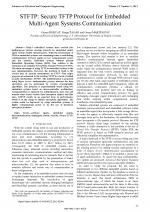| 2/2013 - 4 |
STFTP: Secure TFTP Protocol for Embedded Multi-Agent Systems CommunicationHORVAT, G. |
| View the paper record and citations in |
| Click to see author's profile in |
| Download PDF |
Author keywords
software agents, embedded system, telecommunication, multiagent system, security, Secure TFTP, TFTP
References keywords
embedded(12), systems(11), agent(10), design(9), security(8), system(7), link(7), protocol(6), software(5), authentication(5)
Blue keywords are present in both the references section and the paper title.
About this article
Date of Publication: 2013-05-31
Volume 13, Issue 2, Year 2013, On page(s): 23 - 32
ISSN: 1582-7445, e-ISSN: 1844-7600
Digital Object Identifier: 10.4316/AECE.2013.02004
Web of Science Accession Number: 000322179400004
SCOPUS ID: 84878949461
Abstract
Today's embedded systems have evolved into multipurpose devices moving towards an embedded multi-agent system (MAS) infrastructure. With the involvement of MAS in embedded systems, one remaining issues is establishing communication between agents in low computational power and low memory embedded systems without present Embedded Operating System (EOS). One solution is the extension of an outdated Trivial File Transfer Protocol (TFTP). The main advantage of using TFTP in embedded systems is the easy implementation. However, the problem at hand is the overall lack of security mechanisms in TFTP. This paper proposes an extension to the existing TFTP in a form of added security mechanisms: STFTP. The authentication is proposed using Digest Access Authentication process whereas the data encryption can be performed by various cryptographic algorithms. The proposal is experimentally tested using two embedded systems based on micro-controller architecture. Communication is analyzed for authentication, data rate and transfer time versus various data encryption ciphers and files sizes. STFTP results in an expected drop in performance, which is in the range of similar encryption algorithms. The system could be improved by using embedded systems of higher computational power or by the use of hardware encryption modules. |
| References | | | Cited By |
Web of Science® Times Cited: 8 [View]
View record in Web of Science® [View]
View Related Records® [View]
Updated 3 days, 1 hour
SCOPUS® Times Cited: 8
View record in SCOPUS® [Free preview]
View citations in SCOPUS® [Free preview]
[1] Towards Efficient Application of Cryptographic Schemes on Constrained Microcontrollers, Malina, Lukas, Hajny, Jan, Mlynek, Petr, Machacek, Jiri, Svoboda, Radomir, Journal of Circuits, Systems and Computers, ISSN 0218-1266, Issue 10, Volume 25, 2016.
Digital Object Identifier: 10.1142/S0218126616501292 [CrossRef]
[2] Security Protocol Function Using Quantum Elliptic Curve Cryptography Algorithm, Sudharson, K., Arun, S., Intelligent Automation & Soft Computing, ISSN 1079-8587, Issue 3, Volume 34, 2022.
Digital Object Identifier: 10.32604/iasc.2022.026483 [CrossRef]
[3] Extending hybrid approach to secure Trivial File Transfer Protocol in M2M communication: a comparative analysis, Mohamed, Nur Nabila, Mohd Yussoff, Yusnani, Mat Isa, Mohd Anuar, Hashim, Habibah, Telecommunication Systems, ISSN 1018-4864, Issue 4, Volume 70, 2019.
Digital Object Identifier: 10.1007/s11235-018-0522-5 [CrossRef]
[4] FLEX-IoT: Secure and Resource-Efficient Network Boot System for Flexible-IoT Platform, Park, Keon-Ho, Kim, Seong-Jin, Yun, Joobeom, Lim, Seung-Ho, Park, Ki-Woong, Sensors, ISSN 1424-8220, Issue 6, Volume 21, 2021.
Digital Object Identifier: 10.3390/s21062060 [CrossRef]
[5] Security of Multi-Agent Cyber-Physical Systems: A Survey, Owoputi, Richard, Ray, Sandip, IEEE Access, ISSN 2169-3536, Issue , 2022.
Digital Object Identifier: 10.1109/ACCESS.2022.3223362 [CrossRef]
Disclaimer: All information displayed above was retrieved by using remote connections to respective databases. For the best user experience, we update all data by using background processes, and use caches in order to reduce the load on the servers we retrieve the information from. As we have no control on the availability of the database servers and sometimes the Internet connectivity may be affected, we do not guarantee the information is correct or complete. For the most accurate data, please always consult the database sites directly. Some external links require authentication or an institutional subscription.
Web of Science® is a registered trademark of Clarivate Analytics, Scopus® is a registered trademark of Elsevier B.V., other product names, company names, brand names, trademarks and logos are the property of their respective owners.
Faculty of Electrical Engineering and Computer Science
Stefan cel Mare University of Suceava, Romania
All rights reserved: Advances in Electrical and Computer Engineering is a registered trademark of the Stefan cel Mare University of Suceava. No part of this publication may be reproduced, stored in a retrieval system, photocopied, recorded or archived, without the written permission from the Editor. When authors submit their papers for publication, they agree that the copyright for their article be transferred to the Faculty of Electrical Engineering and Computer Science, Stefan cel Mare University of Suceava, Romania, if and only if the articles are accepted for publication. The copyright covers the exclusive rights to reproduce and distribute the article, including reprints and translations.
Permission for other use: The copyright owner's consent does not extend to copying for general distribution, for promotion, for creating new works, or for resale. Specific written permission must be obtained from the Editor for such copying. Direct linking to files hosted on this website is strictly prohibited.
Disclaimer: Whilst every effort is made by the publishers and editorial board to see that no inaccurate or misleading data, opinions or statements appear in this journal, they wish to make it clear that all information and opinions formulated in the articles, as well as linguistic accuracy, are the sole responsibility of the author.





